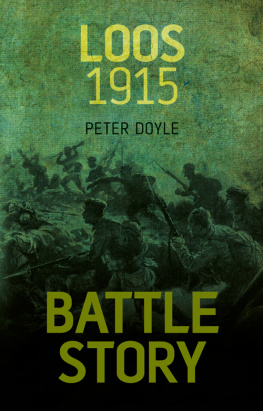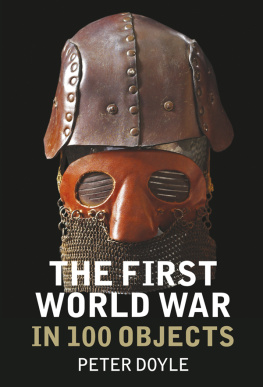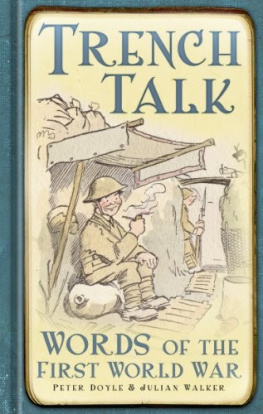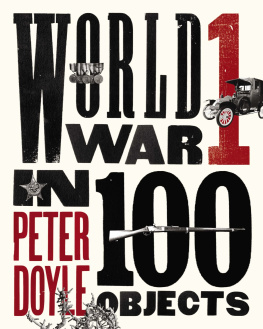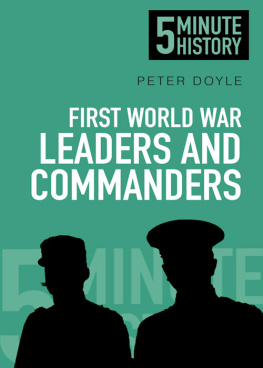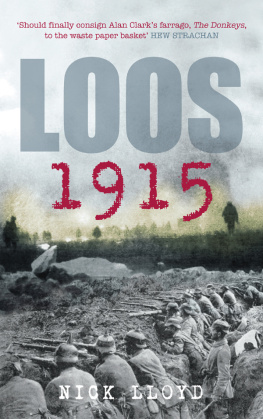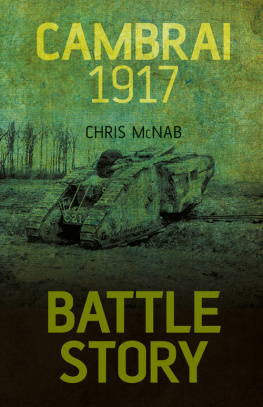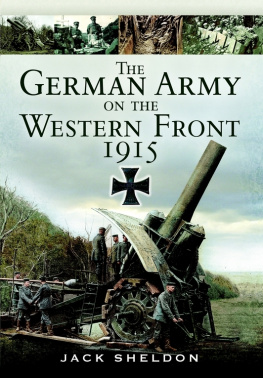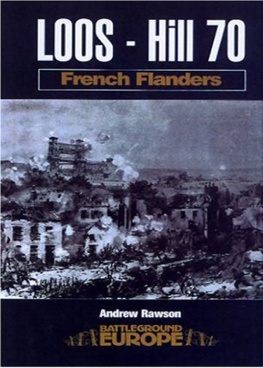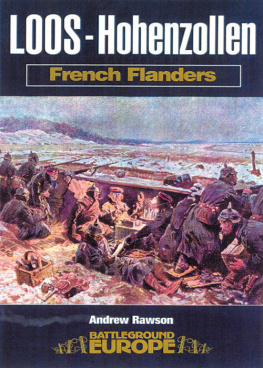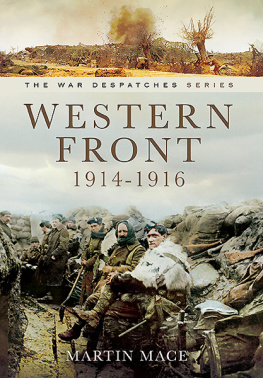In attempting to write a readable introduction to the subject, I owe a debt to those authors who have endeavoured before me; I am particularly grateful for the rich legacy left by Sir James Edmonds remarkably lucid official account. I am also grateful for contemporary accounts written by authors who served: Patrick MacGill in The Great Push (1915); Ian Hay in The First Hundred Thousand (1915) ; and James Norman Hall in Kitcheners Mob (1916). I thank Nigel Wilkinson, of the London Irish Rifles, for his hospitality and the chance to examine the football of Loos, and for permission to use images of the London Irish; Paul Reed for his support; and Paul Evans for his companionship on a damp day on the battlefield. Julie and James are my greatest support. Thanks also to Jo de Vries for her enthusiastic interest. Other than those Ive taken or that are from my collection, the illustrations have been gathered from the pictorial publications of the day. Particularly important are The War Illustrated (Amalgamated Press), The Illustrated War News and The Manchester Guardian History of the War . I am also grateful for access to the free online resources of the Great War Picture Archive and the Library of Congress. The Loos battlefield is still strangely disturbing, even today. Industry and battle scarred, the clouds hang heavily over this part of French Flanders, often ignored by most who travel to the modern city of Lens or on to Arras. A pause here will repay the curious.
By the end of the month we had seen more suffering and death than it is good for men to see in a life time.
James Norman Hall, Kitcheners Mob , 1915
The first two days of the battle had been decisive. There would be no spectacular breakthrough of the German lines. Instead, Loos would continue in a desultory manner into October. Most of the attacks would be limited, as would their aims, and they would simply add to the mounting casualties.
By the close of action on 26 September the line had been stabilised by the arrival of the experienced troops of the Guards Division, as well as the 3rd Cavalry Division. North of the Guards, however, in the vicinity of the hotly contested ground either side of the VermellesHulluch road, the men of the 9th Division, and particularly the three battalions of the 24th Division (73rd Brigade: 9th Royal Sussex, 12th Royal Fusiliers and 7th Northants), were in a parlous state. Exhausted, and without much food and water since coming up into their advanced positions, their grip on the line was tenuous. It would be severely tested in the early hours of the 27th, when the Germans counter-attacked at The Dump and the Hohenzollern Redoubt. With The Dump lost, and Fosse 8 behind it, the redoubt was severely threatened. Major General Thesiger, 9th Division, would be killed in an attempt to review the situation; his loss added to the growing roster of senior casualties during this battle. Fortunately, reinforced by men of the 5th Camerons and 8th Black Watch from the 9th Division (26th Brigade), the redoubt, already hard fought over, would be saved.

48. The ruins of Loos with Tower Bridge in the distance.
For his part, General Haigs plans for the 27th had centred on securing his fragile front, the steady hands of the Lord Cavans Guards Division ensuring that this aim would be met. However, the glowering lump of Hill 70 and the shattered remains of the village of Hulluch still remained in German hands, reminders of the failed attempt to pierce fatally the enemys lines. Cavan and XI Corps commander General Haking still regarded Hill 70 as a realistic target for a limited offensive to be resumed on 28 September. The objectives were shrinking, the opportunities for a major breakthrough lost. The all-out offensive originally planned was now distilling down to a classic bite-and-hold approach. Whether this hill could be bitten off and held by the British was another matter. After a limited bombardment, the Guards reached the hill, Bois Hugo still presenting a problem on the left flank of the operation. Nevertheless, the topography of the hill was to play its part, as described by the official historian:
From the summit the lower part of Hill 70 is dead ground, the chalk slope being convex, and at first few casualties were incurred, but on reaching the upper part a violent machine-gun fire swept the lines. Casualties were at once extremely heavy, and after a few short rushes no further progress was possible. Every effort to move on again brought a burst of fire and further slaughter.
Brigadier General Sir James Edmonds
With the Guards held in this difficult position, the 47th Division assaulted Chalk Pit Copse, to the west of the LensLa Basse road, in front of the hill. Preceded by an effective artillery bombardment, the Londoners were able to secure the wood. To the north, at Cuinchy, a gas attack was to clear the way for the 2nd Division to make some progress against the still intractable German lines. Once again, with a poverty of contours, the gas refused to budge eastwards; the 2nd Division wisely declined to leave their trenches. Another day had gone by, and the chances of any progress were limited. The battle had long since run out of steam.
L T J OHN K IPLING
Rudyard Kiplings son, Lt John Kipling, of the 3rd Battalion, Irish Guards, was posted missing on 27 September, during the assault of the Guards Division. He was last seen close to Chalk Pit Wood. Though the famous author spent the rest of his life searching for his son, it was not until 1992 that a grave in St Marys ADS Cemetery was marked for John Kipling. Some historians dispute the accuracy of this identification.
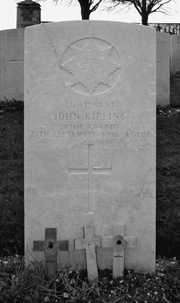
49. The grave of Lt John Kipling, St Marys ADS Cemetery.
The British commander-in-chief was now placed in a difficult position; with the resources having been expended on this costly gamble, Sir John French was forced to contact Joffre to ask for assistance. The French offensive in Artois had reached its high-water mark, at Point 140 on Vimy Ridge on 28 September, and the commander of the French Tenth Army, General dUrbal, had hoped to press on with all his resources. The British converged with the French Army to the south of Loos, and here, as previously agreed, and with the town of Lens in the way, the French IX Corps stood on the defensive, its 152nd Division in reserve; it was the 152nd that was now the point of contention. With General dUrbal eyeing this reserve division, it was General Foch, commander of the northern armies, who determined that the offensives should be held until there could be active co-ordination between the French and British forces. Foch had agreed to relieve the situation for Sir John by moving the French IX Corps up to take on the village of Loos, as well as the looming presence of Hill 70 behind. The French now took over the line at Loos; together the British XI Corps now reinforced by two Territorial divisions, the 12th (Eastern) and 46th (North Midland), which replaced the shattered 21st and 24th divisions and the French IX Corps would take on the assault against Hill 70 and the German second line. The attack would attempt to punch through the salient created by the German line in this position; but this ambition would be severely curtailed by the fact that the Germans still held on tightly to their positions at Hulluch, Fosse 8 and The Dump. The British would have to attempt clearing these positions first; they would remain open sores that the Germans continued to pick away at with constant shelling and incessant attacks with hand grenades. In order to cap this, slowly, the Germans started to gain control of the approaches to the Hohenzollern Redoubt, the heavily entrenched position that had always been viewed as a major sticking point. The redoubt would fall, once again, into enemy hands, retaken by them on 3 October; only the southern trench extension, Big Willie, would remain in British hands. The barricaded join would be a difficult position to hold in the face of grenade attacks:

